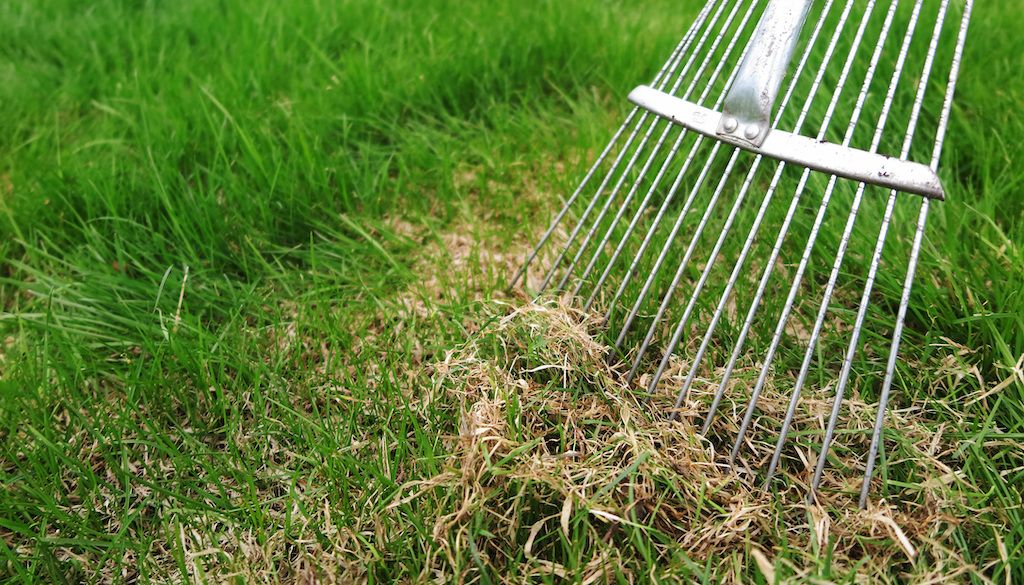What is thatch, and what is lawn dethatching?
Thatch is a layer of dead grass blades and other organic matter above your soil.
A 1/2-inch layer of thatch is actually good for your lawn. It prevents weed growth, protects the soil from frost and helps the soil retain water.
However, if the layer of thatch is any thicker, it can cause problems for your plants. Excess thatch buildup can prevent water and vital nutrients from reaching the soil. This is when dethatching may be needed.

Dethatching is the process of removing the thatch layer using a vertical mower, verticutter and/or power rake. These machines use vertical tines to agitate and break up the thatch. Similar to core aeration, dethatching removes parts of the top layer of soil.
If you have the right equipment, you can dethatch yourself. If not, you may want to hire a professional lawn care service for this task.
Related: Dethatching your lawn: When, how and why you should.
Pros of dethatching your lawn.
If the layer of thatch in your yard is thicker than 1/2 inch, dethatching can have several benefits. Consider the pros of dethatching as part of your lawn care plan:
Better nutrient absorption.
Excessive thatch buildup can prevent nutrients from reaching the soil. It can also make it more difficult for roots to get nutrients from the soil.
Dethatching can help your grass get the nourishment it needs for optimal growth. The resulting healthy root system will help to prevent future thatch buildup.
Improved air and water circulation.
Too much thatch can hinder the movement of water and air through your soil, too. If your soil retains too much moisture, it can lead to fungal growth. Insufficient airflow can also reduce the effectiveness of fertilizers and pesticides. Dethatching will improve the flow of water and air in your soil.
More effective fertilizing and overseeding.
A freshly dethatched lawn offers better contact with the soil for grass seeds and fertilizer. After dethatching, you’ll see better results from fertilization and overseeding.
It’s usually best to dethatch and overseed at the end of the summer or early fall. But this also depends on the type of grass you have.
Cons of dethatching your lawn.
Although dethatching can have many benefits for your lawn, you may run into some issues. Consider the cons of dethatching carefully before going through with it. When in doubt, consult a lawn care professional to determine if it’s right for your lawn.
Potential damage to the grass.
If you don’t time dethatching right, it can cause permanent damage to your grass. You should only dethatch when your grass is actively growing so it can recover from the stress of dethatching.
Determine what kind of grass is in your lawn so you can dethatch at the best time. If you have warm-season grass, plan to dethatch in the late spring or early summer. If you have cool-season grasses, plan for early spring or early fall.
Temporary lawn appearance.
Removing the thatch buildup in your lawn will leave it looking somewhat ragged, and this is by design. The process is inherently destructive, so you may see patches of exposed soil or uneven growth.
As long as you time it correctly, however, your lawn should recover quickly. With core aeration, fertilization and overseeding, your grass will regain its lush appearance after dethatching.
Brings weed seeds into the open.
Timing is also important when it comes to weed seeds. During the spring, weed seeds are ready to germinate, and dethatching can help with that process.
The end result? You have a large number of weeds in your yard. Avoid dethatching during the spring to avoid this.
So, should you dethatch your lawn?
There are a few indicators of excessive thatch buildup in your lawn. If you notice any of these signs, you may need to dethatch:
- A layer of thatch exceeding half an inch
- A “bouncy” feeling when you walk on your soil
- Excessive pests or fungal growth
- Insufficient or uneven grass growth
However, you should only dethatch if your lawn needs it because it puts a lot of stress on your grass. If your plants grow normally and you don’t have issues with water runoff, you may want to hold off on dethatching.
Core aeration is a less invasive process that can help with compacted soil and prevent thatch buildup.
Consult a lawn care service on Thumbtack.
Homeowners can certainly dethatch the lawn themselves. However, it’s a time-consuming and labor-intensive process, so you may want to hire a professional. If done incorrectly or at the wrong time, dethatching can cause serious problems for your grass. A professional will typically have access to more efficient equipment and get the job done faster.
The easiest way to find a lawn care service near you is with Thumbtack. Download the app today to find the right pro for your lawn care needs.
Related: How much do lawn services cost?
FAQs
Will grass grow back after dethatching?
Yes, your lawn will gradually recover after dethatching. Although it may appear sparse initially, fertilizing and overseeding will help your grass grow back faster and healthier.
Is it better to aerate or dethatch?
Although core aeration and dethatching are similar, they serve slightly different purposes.
Dethatching breaks up and removes an entire layer of thatch buildup from the top of your soil. Aeration is the process of removing small “cores” of soil to help it circulate air and water.
Aerating typically puts less stress on the grass and should occur after you dethatch.
A note about project costs included or linked in this article: Figures represent national average cost estimates using data provided by Thumbtack pros and additional research. These figures are provided for educational purposes only and are subject to change at any time due to various factors. Details about your specific project and local rates can impact costs.